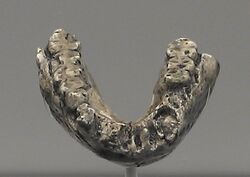Biology:LH 4
From HandWiki
Short description: Hominin fossil
 | |
| Catalog no. | LH 4 |
|---|---|
| Common name | Laetoli Hominid 4 |
| Species | Australopithecus afarensis |
| Age | 2.9–3.9 million years |
| Place discovered | Laetoli, Tanzania |
| Date discovered | 1974 |
| Discovered by | Mary Leakey |
LH 4 or Laetoli Hominid 4[1] is the catalogue number of a fossilized mandible which was discovered by Mary Leakey in 1974 from Laetoli, Tanzania.[2]
Mary Leakey and her team, including Tim White,[3] found between 1974 and 1977 forty-two hominid teeth associated with a jawbone. One of them was LH-4, a fine specimen with nine teeth. White described the fossils, and LH-4 was assigned as the "name-bearer" of the new species by Don Johanson and White.[3]
Observations
The specimen is 2.9–3.9 million years old and is mandible of an adult Australopithecus afarensis with all molars present and a fairly large canine.[4][5] Most anterior teeth and rami are missing. But, the dental arcade is in a good condition with little or no evidence of distortion.[2]
References
- ↑ "Lateoli". ntz.info. http://www.ntz.info/gen/n00322.html.
- ↑ 2.0 2.1 "LH 4". eFossils. http://www.efossils.org/page/boneviewer/Australopithecus%20afarensis/LH%204.
- ↑ 3.0 3.1 Meredith, Martin (18 August 2011). Born in Africa: The Quest for the Origins of Human Life. Simon and Schuster. pp. 288. ISBN 9780857206671. https://books.google.com/books?id=XJK1zIgG9TMC&pg=PR77.
- ↑ Tanner, Nancy Makepeace (31 August 1981). "Evidence on the transition: what can the earliest hominid fossils reveal about the ancestral population and the translation?". On Becoming Human. CUP Archive. p. 180. ISBN 978-0-521-28028-0. https://books.google.com/books?id=_j45AAAAIAAJ&pg=PA169. Retrieved 16 October 2012.
- ↑ Clarke 2012, p. 48.
Bibliography
External links
| Wikimedia Commons has media related to LH 4. |
 |

